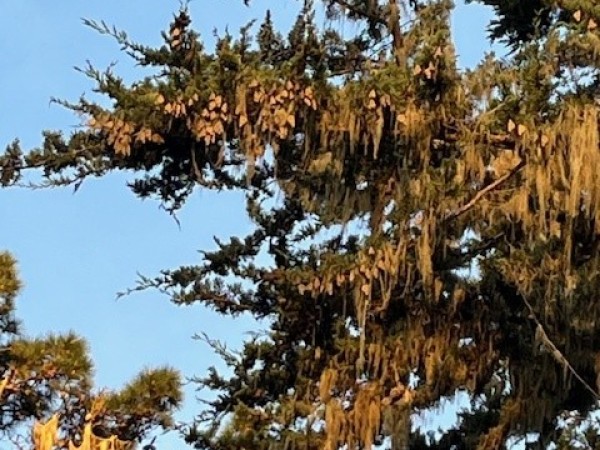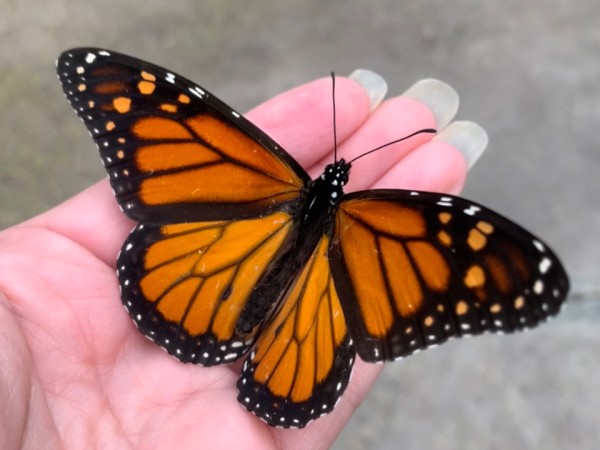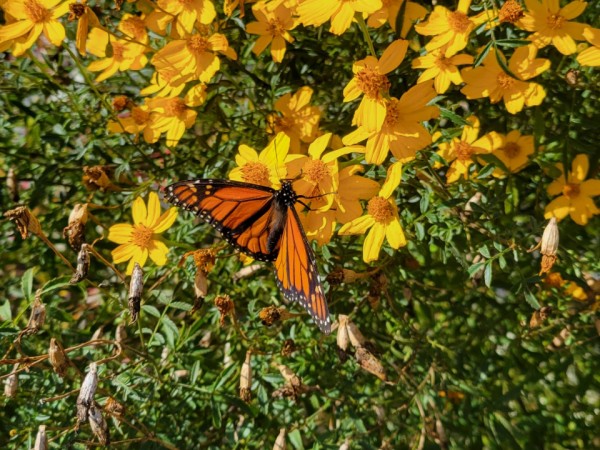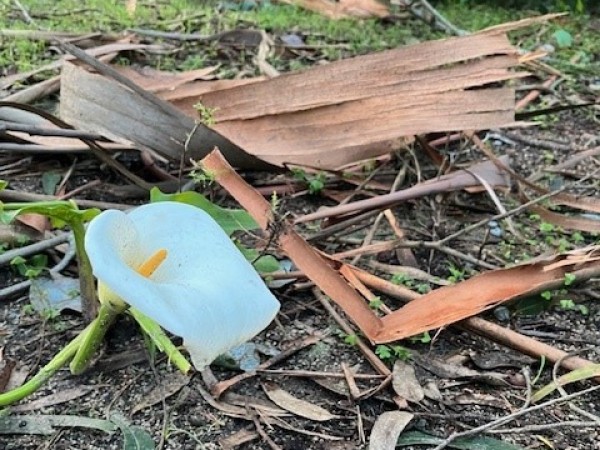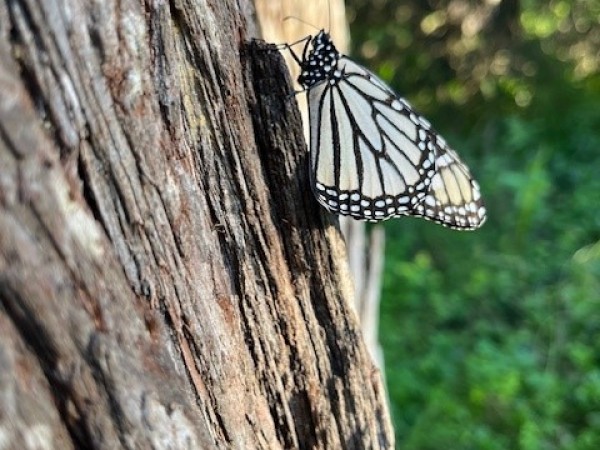2024 Spring Letter #1: Western Monarch Population News From Gail Morris
From a Peaceful Winter to Fierce Winds
It had been a relatively peaceful winter overwintering season on the California coast. Then suddenly monarchs were confronted by fierce winds and pummeling rain last week just as they began to leave the groves. Everyone is wondering how the monarchs fared. Stephanie Tucotte traces their movements at Pacific Grove before the storm hit and how the monarchs fared after the storm. Diana Magor shares the post-storm observations at Lighthouse Fields in Santa Cruz, California.
Journey North Recent Observations
Here is a sample of reports received by Journey North:
Julie in Tempe, AZ: “I found this Monarch on the ground upside down. It was in the morning between 9 am and 10 am. The weather was cold, overcast, and drizzling. I scooped him up into my hands to warm him up. I didn’t want him getting trampled by the dogs. Once he moved his wings and started crawling along my hand, I placed him in a creosote bush. I went back to check on him 30 minutes later. The sun had come out from behind the clouds. The creosote bush was right in the path of the morning sun. I checked nearby bushes. He was mostly definitely gone and had flown away.”
This time of year cold temperatures in the shade can prevent monarchs from flying. Once it gets warmer they can once again be on their way. Your sightings can help us all see where milkweed is up and the weekly monarch movement as the Spring Migration unfolds. Adding a few words or sentences about your observations can help everyone learn about the best milkweed and flowers to plant to help monarchs on their way! Visit the Journey North Maps for more information about monarch and milkweed observations.
Reports from the Field
Pacific Grove, California
This week Stephanie Turcotte offers us an overview of 2024 activity as well as recent update at the Monarch Sanctuary at Pacific Grove, California:
Week of January 20, 2024: “After not counting for two of the weekly counts in Pacific Grove, CA, I was unsure what I was going to find. While I was away, a good portion of the monarchs had moved from the interior back onto the Monterey pine “Nexus” that stands along the footpath. Mid-week, I was in the PG Monarch Grove on two separate days for field trips and observed different behaviors on different days. The monarchs had, indeed moved, into Nexus; however, not in large numbers. There were still a strong contingent in the interior, too. They were also clustered in huge numbers on a very spindly Monterey pine nestled between some healthier Monterey cypress, and some monarch clusters very high up in the canopy. This configuration was similar to how monarchs had utilized “Charlie Brown”, also an unhealthy Monterey pine, but much taller and with a wider girth, two seasons ago in the interior. Charlie Brown has had some monarchs on it this season, but not as many because it no longer has as much protection from wind as it did previously. I observed that there were several, fully intact, monarchs on the ground without an abdomen. It was striking only because their wings were still so brightly colored and non-tattered, as though they had recently eclosed.
“Fast forward, one more day to Friday, Jan 19th, I was able to count again. The monarchs had dispersed into far more trees than they had been the day before. They were on 14 different trees, a mix of Monterey pines and Monterey Cypress, including four Eucalyptus trees in the southern end of the grove. We counted a total of 4,477 monarchs clustered, 137 grounders, and a handful of loners and fliers. The total number of monarchs counted was 4,628 monarchs, which took 2.5 hours to count. They were so spread out and very high up in several of the trees. Fortunately, the temperature was 46-48 degrees because they seemed prepared to fly. MP53, the spindly pine had 1,078 monarchs in it (23%) and Nexus now has 1,861 monarchs (40%) in it.”
Week of January 26, 2024: “As for the official count data, they were still in 14 trees, although mostly only in the interior of the grove on ‘Charlie Brown’ Monterey pine and the pines and Cypress that encircled it. Most of the monarchs are very high up, which is where they have been positioning themselves all week and flying as soon as the temps and weather allow. We counted a total of 2,289 monarchs today, Jan. 26th. This is a big difference from last week, but makes sense with all the activity observed (mating and flying from clusters). This particular group seems anxious to get on their way.”
Week of January 31 to February 2, 2024: “I did an informal sweep throughout the grove on Jan 13th, to get a sense of where monarchs were sheltered for the storm; but they appeared strikingly fewer in number. I, loosely, estimated about 500-1000. Oddly enough, they were re-forming clusters at 9:30 am on the Eucalyptus in the western end, above the nectar beds, where they have no protection from the wind. It was blowing 8mph that morning with gusts of 16mph. They were on two Eucalyptus in the south in small clusters and then on a Cypress on the east side along the hotel’s fence. I didn’t see the 2,000+ we had in the previous count.
“The rain this morning, Feb 2nd, gave us a window long enough to be able to complete the count. Although we did have to hide under the trees a few times as rogue rain cells passed through. When we began the count, we were all pretty shocked to find only eight clustered on a single Eucalyptus tree at the southern end of the grove. They were mixed between the real dead leaves of the tree. We searched throughout the interior and found nothing. Just as we began speculating how the season ended so abruptly, we found a mating pair stuck between blades of wet grass! So we moved throughout the deer trails toward the northern end of the habitat and found more and more monarchs seeking refuge in the understory. Then in the clearing where we were all counting grounders, I looked up. There they were, monarchs clustered on the north side of three tall Monterey Cypress trees. Our cluster count was 2,935. Our total count, including the 100+ grounders, was 3,049 monarchs.”
Week of February 9, 2024: “Everyone has been wondering how the monarchs faired, along the west coast, after this severe storm we just experienced in many parts of California. Considering many of us lost power in Pacific Grove, CA due to strong winds, 28mph winds w/ 57mph gusts at times, and heavy rain pulling large Monterey pines from the earth and splitting branches from Monterey cypress and eucalyptus onto power lines and anything else in their way, all we could do was wait. We were especially unsure of what was happening in the monarch habitat to some of the more fragile trees around where the monarchs had been roosting. Thankfully the rain and wind stopped for now. The temperatures have now dropped considerably both here in Pacific Grove, CA, and to the east, northeast of us-even near freezing.
“Walking into the 40 degree monarch habitat with Eucalyptus debris everywhere didn’t make me worry any less. Remarkably, other than the bark strips and small branches everywhere, the trees were all still standing. The monarchs were also visible soon enough. The majority of them are positioned on the east side on a Monterey Cypress, which often hosts the monarchs in this later part of the season, due to the abundance of lace lichen all over it. There are currently 1,690 monarchs on this tree alone. The rest of the monarchs are on the group of Monterey cypress and Monterey pines which are in the northern and northeastern portion of the grove. As expected, they are high up and mostly on east east-facing sides of the trees to receive the sun as soon as possible. We counted them clustered in 8 trees, including “Nexus” the Monterey pine in the southern end, which was the only tree in a different location than the majority of the monarchs. Our count this morning, 2/9/24, was 2,498 monarchs (2,462 clustered and approx. 30 grounders, mostly in and around the base of a tree in the deep north).
Whew…deep sigh of relief. However, I shouldn’t be too surprised because monarchs have shown me season after season that they know what they are doing and where they need to be to survive what nature throws at them. “I have attached some photos from today’s count to illustrate resilience. I guess it helps to temper the sadness/disappointment that many of us are feeling regarding the recent report that came out on the decline of monarch numbers in the east.”
Santa Cruz, California
Diana Magor shares her observations from Lighthouse Field as two atmospheric rivers pounded the California coast and battered many of the monarch overwintering sites. She reports on these visits before, during, and after the storms.
Before the storms: “On Monday, Jan 29th, it was sunny, calm, with temperatures around 53° F. I reported 2,938 but my assistant Dorothy pointed out two large and three small clusters on the N side of a large cypress which had supported many on its south-facing side in past counts, which I had missed. So including the next observation of those clusters (2/3/24) the corrected estimate for 1/29/24 would be 4,700."
Storms Arrive: “On Friday, Feb 2nd, the first big storm arrived with heavy rain and winds. But by Saturday, Feb 3rd, the weather was overcast with sunny and warmer later in the day. The count increased to 5,931. In consultation with John Dayton, he said that the numbers at all the three main Santa Cruz overwintering sites were fluctuating significantly, so perhaps monarchs were moving to and from LF both before and after the storms."
Another Storm Arrives: “On Sunday, Feb. 4th, the largest atmospheric river hit the Central and Southern CA coasts with wind gusts up to 64 mph in Santa Cruz, and caused extensive tree fall. Three Blue Gum Eucalyptus fell within the monarch sanctuary on that day. One tree fell on the south side of the reserve. This tree fell from S to N across the entire reserve and took down several lateral branches of small but significant Cypress trees. When I arrived, at about 2:00 pm, hundreds of monarchs were either on the wet ground or flying around and onto the small Cypress trees and branches of both trees. The ground was waterlogged and there were many pools of water in and around the reserve. Some monarchs were found drowning in the puddles, and those outside the reserve were rescued by people holding sticks and carrying them to higher tree branches. I could not do an actual count on that day due to the number of flyers and grounders and the inability to get to some of the inner trees."
Returning After the Storm: "On Monday, February 5th, a Davey Tree Co team was cutting down two of the large blue gum Eucalyptus at the back (north ) side of the reserve which had fallen across the road and power lines on Pelton Ave. It did not appear that these two trees and the crew inside the reserve had a significant effect on the monarchs. The Eucalyptus inside the reserve has not yet been removed. Once again, monarchs were grounded and flying about trying to find a place to rest. My estimate, including the clusters inside Cypress tree #14, was 2,940. However, Pelton Ave, which forms the N side of the reserve, was closed. I could not survey the northern trees, one of which, a small Monterey Cypress, supported 410 monarchs on its N side on Feb. 6th. I suspect that number should be added to the above count."
Continuing Visits: "On Tuesday, Feb. 6th with Tree Company gone and Pelton Ave now open, I could survey the trees at the N side of the reserve, and counted 410 on a very small Cypress tree close to the road. I had never seen monarchs there before. Several were on the N side of the trees inside the grove, but the large clusters on the N side of the big Cypress tree #14 had been reduced to 513. I don’t feel confident on this day’s count, as there was much activity and I wasn’t able to survey until 2:00 pm, when many were flying and moving from one tree to another. Several were using the Cypress trees adjacent to the ice plant, and about 35 were sunning on the ice plant. The minimum count was 2,362, but Dorothy, who was able to come out around 8:00 pm, estimated closer to 4,000."
Returned Visit: "I returned on Thursday, Feb. 8th, in the morning. All was calm and partly cloudy. Temperatures hovered around 46° F. The count was 4,783. The vast majority of monarchs (around 4,200 ) were on the S and West sides of the three large Monterey Cypress trees on the south side of the reserve. Only about 12 grounders, including mating pairs. Several monarchs were starting to nectar on the abundant Eucalyptus blossoms on the huge eucalyptus just west of the cordoned-off area. The inside of the sanctuary is quite noticeably more open than it was before the tree fall."
In Sum: “The situation on the ground is similar to the one Stephanie Turcott describes in her report, except that now we have three fewer large Eucalyptus trees in the sanctuary, which now appears more open than before the storm. Fortunately, very few monarchs had been clustering or even sunning on the Eucalyptus the days and weeks before the storms. I will continue to monitor the site for the next few weeks. This week is expected to be cold at night (low 40s° F) but gradually warming to about 60° F and partly sunny till next Thursday. Then more rain.”
Thank You!
Thank you to both Stephanie Turcotte and Diana Magor for their reports from Pacific Grove and Santa Cruz in California.
Send in your monarch and milkweed reports!
Be sure to report any milkweed up and monarch sightings to Journey North—whether they are adults or eggs or larvae. Please provide as much information as you can such as weather conditions (it’s okay to estimate). Your detailed description of what you see can include, but is not limited to, the monarch’s gender and activity and, if known, the type of flowers if they are nectaring.
Gail Morris is the Coordinator of the Southwest Monarch Study (www.swmonarchs.org and the Western Monarch Advocates. She is also a Monarch Watch Conservation Specialist, and the Vice President of the Central Arizona Butterfly Association. The Western Monarch Population News is based on comments provided to Gail Morris. We hope to increase the number of sightings and therefore photos and comments entered into the Journey North. We rely on the volunteers who communicate regularly with Gail and who agree to participate in our effort to increase awareness of the population of Western monarchs. You can reach her at gail@swmonarchs.org
